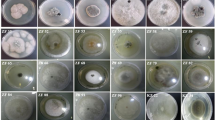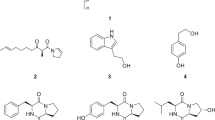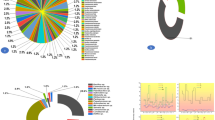Abstract
Two cyclotetrapeptides, henceforth named Provipeptides A (1) and B (2), along with five known diketopiperazines (3–7) were isolated from the liquid culture of marine Streptomyces sp. 161a recovered from a sample of sea grass Bryopsis sp. The structures of cyclotetrapeptides and diketopiperazines (DKPs) were established by 1D and 2D NMR data, MS, and by comparison with literature data. The absolute stereochemistry of compounds cyclo-(l-Pro-l-Leu-d-Pro-l-Phe) 1 and cyclo-(-Pro-Ile-Pro-Phe) 2 was established by the Marfey’s method. Compound 1 showed antibacterial activity against rice phytopathogenic strains Burkholderia glumae (MIC = 1.1 mM) and Burkholderia gladioli (MIC = 0.068 mM), compound 2 was active only against B. glumae (MIC = 1.1 mM), and DKP cyclo-[l-Pro-l-Leu] 5 showed to be active against B. gladioli (MIC = 0.3 mM) and B. glumae (MIC = 2.4 mM). Compounds 1 and 2 showed 65% and 50% inhibition of Colletotrichum gloeosporioides (yam pathogen) conidia germination, respectively at a concentration of 1.1 mM.
Similar content being viewed by others
Log in or create a free account to read this content
Gain free access to this article, as well as selected content from this journal and more on nature.com
or
References
Chica J, Yeimy C, Tirado O, Barreto JM. Indicadores de competitividad del cultivo del arroz en Colombia y Estados Unidos. Rev Cienc Agrícolas. 2016;33:16. http://revistas.udenar.edu.co/index.php/rfacia/article/view/3097.
Giraldo Marroquín N, Bustamante Rodríguez SL, Pinzón Gutiérrez YA, Buitrago Hurtado G. Caracterización molecular de Colletotrichum gloeosporioides aislado de plantas de ñame de la Costa Atlántica Colombiana utilizando la técnica “DNA Amplification Fingerprinting (DAF). Rev Colomb Biotecnol. 2016;18:95–103.
Rai MK, Kalia RK, Singh R, Gangola MP, Dhawan AK. Developing stress tolerant plants through in vitro selection—an overview of the recent progress. Environ Exp Bot. 2011;71:89–98.
Prévost K, Couture G, Shipley B, Brzezinski R, Beaulieu C. Effect of chitosan and a biocontrol streptomycete on field and potato tuber bacterial communities. BioControl. 2006;51:533–46.
Aktar W, Sengupta D, Chowdhury A. Impact of pesticides use in agriculture: their benefits and hazards. Interdiscip Toxicol 2009;2:1–12.
Blunt JW, Copp BR, Keyzers RA, Munro MHG, Prinsep MR. Marine natural products. Nat Prod Rep [Internet]. 2017;34:235–94. http://xlink.rsc.org/?DOI=C6NP00124F.
Kong, Q. Marine microorganisms as biocontrol agents against fungal phytopathogens and mycotoxins. Biocontrol Science and Technology. 2018;28:77–93. https://doi.org/10.1080/09583157.2017.1419164.
Manivasagan P, Venkatesan J, Sivakumar K, Kim SK. Marine actinobacterial metabolites: current status and future perspectives. Microbiol Res. 2013;168:311–32. https://doi.org/10.1016/j.micres.2013.02.002.
Newman DJ. Developing natural product drugs: Supply problems and how they have been overcome. Pharmacol Ther. 2016;162:1–9. https://doi.org/10.1016/j.pharmthera.2015.12.002.
Newman DJ, Cragg GM. Natural products as sources of new drugs over the 30 years from 1981 to 2010. J Nat Prod. 2012;75:311–35.
Hassan SSul, Shaikh AL. Marine actinobacteria as a drug treasure house. Biomed Pharmacother. 2017;87:46–57.
ul Hassan SS, Anjum K, Abbas SQ, Akhter N, Shagufta BI, SAA Shah, et al. Emerging biopharmaceuticals from marine actinobacteria. Environ Toxicol Pharmacol. 2017;49:34–47.
Newman DJ, Cragg GM. Natural products as sources of new drugs over the last 25 years. J Nat Prod. 2007;70:461–77.
Betancur LA, Naranjo-Gaybor SJ, Vinchira-Villarraga DM, Moreno-Sarmiento NC, Maldonado LA, Suarez-Moreno ZR, et al. Marine actinobacteria as a source of compounds for phytopathogen control: an integrative metabolic-profiling/bioactivity and taxonomical approach. Virolle M-J, editor. PLoS ONE. 2017;12:e0170148. http://dx.plos.org/10.1371/journal.pone.0170148.
Marfey P Determination of o-amino acids. II. Use of a bifunctional reagent, 1,5-difluoro-2,4-dinitrobenzene by [Internet]. Vol. 49, Carlsberg Res. Commun. 1984. https://link.springer.com/content/pdf/10.1007%2FBF02908688.pdf.
Balouiri M, Sadiki M, Ibnsouda SK. Methods for in vitro evaluating antimicrobial activity: A review. J Pharm Anal. 2016;6:71–9. http://linkinghub.elsevier.com/retrieve/pii/S2095177915300150.
Moreno-Moran M, Burbano-Figueroa O. First report of Colletotrichum gossypii var. cephalosporioides causing cotton ramulosis in Colombia. Plant Dis. 2016 Mar;100:653–653.
Rungprom W, Siwu ERO, Lambert LK, Dechsakulwatana C, Barden MC, Kokpol U, et al. Cyclic tetrapeptides from marine bacteria associated with the seaweed Diginea sp. and the sponge Halisarca ectofibrosa. Tetrahedron. 2008;64:3147–52.
Rajiv D, Hemendra G. Synthesis and pharmacological studies on a cyclooligopeptide from marine bacteria. Chin J Chem. 2011;29:1911–6.
Li X, Dobretsov S, Xu Y, Xiao X, Hung O, Qian PY. Antifouling diketopiperazines produced by a deep-sea bacterium, Streptomyces fungicidicus. Biofouling. 2006;22:201–8.
Bao J, Zhang XY, Xu XY, He F, Nong XH, Qi SH. New cyclic tetrapeptides and asteltoxins from gorgonian-derived fungus Aspergillus sp. SCSGAF 0076. Tetrahedron. 2013;69:2113–7.
Kalinovskaya NI, Romanenko LA, Kalinovsky AI. Antibacterial low-molecular-weight compounds produced by the marine bacterium Rheinheimera japonica KMM 9513T. Antonie van Leeuwenhoek, Int J Gen Mol Microbiol. 2017;110:719–26.
Kumar N, Mohandas C, Nambisan B, Kumar DRS, Lankalapalli RS. Isolation of proline-based cyclic dipeptides from Bacillus sp. N strain associated with rhabitid entomopathogenic nematode and its antimicrobial properties. World J Microbiol Biotechnol. 2013;29:355–64.
Wattana-Amorn P, Charoenwongsa W, Williams C, Crump MP, Apichaisataienchote B. Antibacterial activity of cyclo(L-Pro-L-Tyr) and cyclo(D-Pro-L-Tyr) from Streptomyces sp. strain 22-4 against phytopathogenic bacteria. Nat Prod Res. 2016;30:1980–3.
Acknowledgements
This study was conducted with the financial support of COLCIENCIAS (grant Cod. 1101-659-44402 CT.537/14) and International Foundation for Science IFS, Uppsala-Sweden (grant Cod. 5023–2). Universidad Nacional de Colombia DIEB grant 37151. L.A.B thanks the Programa Doctoral Becas Colciencias (567) for the granted scholarship (2012), Universidad de Caldas for the leave of absence for doctoral studies. The ANLA (Agencia Nacional de Licencias Ambientales) and the Ministerio de Ambiente y Desarrollo Sostenible granted permission to collect samples and perform this research (Permission No 4 of 10/02/2010, Anexo 2, Contrato de Acceso a Recurso Genético No 108).
Author information
Authors and Affiliations
Corresponding author
Ethics declarations
Conflict of interest
The authors declare that they have no conflict of interest.
Additional information
Publisher’s note: Springer Nature remains neutral with regard to jurisdictional claims in published maps and institutional affiliations.
Supplementary information
Rights and permissions
About this article
Cite this article
Betancur, L.A., Forero, A.M., Romero-Otero, A. et al. Cyclic tetrapeptides from the marine strain Streptomyces sp. PNM-161a with activity against rice and yam phytopathogens. J Antibiot 72, 744–751 (2019). https://doi.org/10.1038/s41429-019-0201-0
Received:
Revised:
Accepted:
Published:
Issue date:
DOI: https://doi.org/10.1038/s41429-019-0201-0



